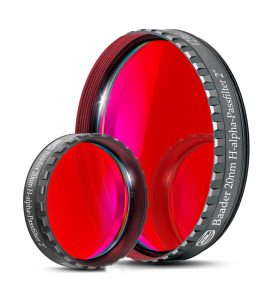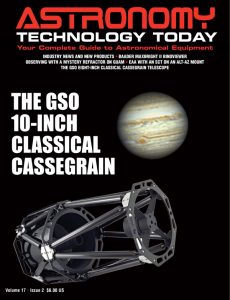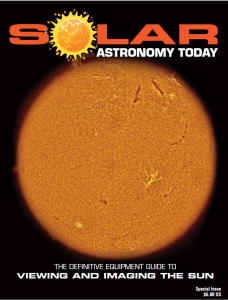The Baader H-alpha Bandpass Filter is the successor to the previous Baader 35 nm H-alpha CCD pass filter utilizing a new, highly effective UV/IR block coating from 300 nm to 1400 nm. The FWHM is now offered at 20 nm (ZWL 656.3), making this filter ideal for nighttime visual use – and photographically with CCD and CMOS cameras and any telescope aperture ratio. It is available in 1.25” and 2” versions.
 Similar to the Super G filter in O III, the 20 nm H-alpha filter is an excellent contrast deep-sky H-alpha red filter for RGB applications, optimized for all color CCD and CMOS chips. It enables high-contrast images of H-II regions (such as the North America nebula) even from “light-polluted” surroundings. The Baader H-alpha Bandpass Filter can benefit the use of color cameras if no extreme narrow-band filters are to be used and if the red H-alpha component is to be emphasized as much as possible in color recordings making it an alternative to a standard red RGB filter.
Similar to the Super G filter in O III, the 20 nm H-alpha filter is an excellent contrast deep-sky H-alpha red filter for RGB applications, optimized for all color CCD and CMOS chips. It enables high-contrast images of H-II regions (such as the North America nebula) even from “light-polluted” surroundings. The Baader H-alpha Bandpass Filter can benefit the use of color cameras if no extreme narrow-band filters are to be used and if the red H-alpha component is to be emphasized as much as possible in color recordings making it an alternative to a standard red RGB filter.
As the Baader team notes, “Compared to the CMOS-optimized Baader (Ultra) narrowband filters, the 20 nm H-alpha filter lets more light through. This makes the stars in the image brighter, making it easier to focus, and this filter can be used at all apertures. The narrower band filter required preshifting is omitted. This filter is a real alternative to a standard R filter of the RGB scheme. It blocks much more of the harmful light pollution while still allowing maximum H-alpha signal to pass through for all focal ratios. A notable difference from all H-alpha pass filters on the market is the fact that this filter contains a highly efficient UV/IR cutoff that blocks completely up to 1400nm to avoid blur (“heat noise”) caused by defocused light caused by refractor optics.”
You can learn more about the Baader H-alpha Bandpass Filter here.

 And to make it easier for you to get the most extensive news, articles and reviews that are only available in the magazine pages of Astronomy Technology Today, we are offering a 1-year magazine subscription for only $6! Or, for an even better deal, we are offering 2 years for only $9. Click here to get these deals which only will be available for a very limited time. You can also check out a free sample issue here.
And to make it easier for you to get the most extensive news, articles and reviews that are only available in the magazine pages of Astronomy Technology Today, we are offering a 1-year magazine subscription for only $6! Or, for an even better deal, we are offering 2 years for only $9. Click here to get these deals which only will be available for a very limited time. You can also check out a free sample issue here.
The sun is more active than it has been in years! If you’d like to learn more the technology behind solar observing, solar imaging and more, you can check out our free publication, “The Definitive Guide to Viewing and Imaging the Sun”. You don’t have to sign up or provide any information, simply click here and enjoy reading!

